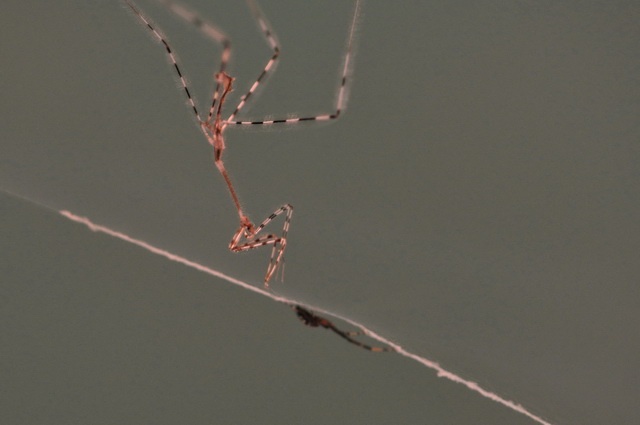Assassin bug sneaks in the web to eat the deadly spider
Thanks to a stealthy hunting tactic, the giraffe assassin bug is able to prey on web building spiders. Fernando Soley unravelled how the bug manages to approach a spider unnoticed.
With their sticky webs and their venom, web building spiders are formidable predators of insects and other small animals. Webs and venom also make a powerful defence and it is nearly impossible for small animals to prey on spiders. Still, some critters feed on these predators, risking their lives.
One of the most remarkable spider eating species is the giraffe assassin bug, Stenolemus giraffa, an inhabitant of the northern, tropical part of Australia. It has a weird appearance, as a long ‘giraffe’s neck’ (pronotum) extends between the head with part of the thorax and the rest of the thorax with the thin abdomen. Antennae and front legs are placed at one end of the neck, middle legs and hind legs at the other end. The bug lives on rock escarpments and is often found associated with spider webs because it is araneophagic: it preys on web building spiders. After grasping one, it inserts the tip of its rostrum (piercing mouthparts) into the spider’s abdomen to feed on the contents. Feeding takes an hour or longer.
Cautious
How is this delicate looking bug able to approach and attack a dangerous spider in her web? To find out, Fernando Soley observed the bugs under natural conditions and conducted experiments in the lab.
The giraffe bug spends nearly half his time on stalking resting spiders, as Soley noticed. If he perceives one, he first tries to access it without touching the web, for the spider will perceive any vibration of the threads. Hanging from the rock on middle and hind legs the enemy cautiously progresses. If he is close enough, he bends to his prey and stretches his forelegs to grab it. The long legs and giraffe neck facilitate this way of hunting.
But often, he cannot reach the spider without invading the web. Soley made artificial webs of spider’s silk and placed them in front of a laser vibrometer in order to measure the vibrations produced when a bug steps on a thread. It turned out that those vibrations are very soft and hardly detectable. Because of the long body and the long legs, the bug’s weight is distributed over a large surface area. Besides, it moves slowly, pausing after each step.
Wind
Great difficulties arise when the spider rests at the opposite side of the web. Then the assassin bug has to break some threads next to the spider with its forelegs to be able to capture it. He does so very carefully. To prevent the ends from snapping back after the break and alerting the spider, the bug holds on to the loose ends for a while, causes them to sag and then releases them carefully. After releasing the first loose end, he waits several seconds or even minutes before he releases the second one to space out the vibrations in time. In this way, Soley reports, the bug strongly attenuates the vibrations produced, making them often indistinguishable from background noise.
If a wind blows, things are easier, as vibrations are less conspicuous and the bug can move faster. So, it prefers to breaks threads in the presence of wind.
Long rest
In spite of this stealthy behaviour, there is a risk that the spider notices the steps of the giraffe assassin bug or the breaking of threads and either escapes or attacks. Occasionally, the hunting bug becomes prey himself. The success rate of his attacks is only 20 per cent, but if he succeeds, rewards for his patience and careful behaviour are high. After having overpowered and eaten a spider, the bug can rest for days, digesting this meal.
Willy van Strien
This is an update of an earlier version in Dutch
Photo: Giraffe assassin bug Stenolemus giraffa. © Fernando Soley
Sources:
Soley, F.G., 2016. Fine-scale analysis of an assassin bug’s behaviour: predatory strategies to bypass the sensory systems of prey. Royal Society Open Science 3: 160573. Doi: 10.1098/rsos.160573
Soley, F.G. & P.W. Taylor, 2012. Araneophagic assassin bugs choose routes that minimize risk of detection by web-building spiders. Animal Behaviour 84: 315-321. Doi:10.1016/j.anbehav.2012.04.016
Soley, F.G., R.R. Jackson & P.W. Taylor, 2011. Biology of Stenolemus giraffa (Hemiptera: Reduviidae), a web invading, araneophagic assassin bug from Australia. New Zealand Journal of Zoology 38: 297-316. Doi: 10.1080/03014223.2011.604092
